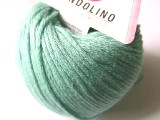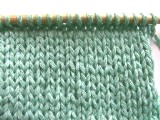

Yarn Profile: Bandolino First Impressions
Bandolino is composed of one, single strand of yarn that has been knitted in the round, forming a long spaghetti-like tube. The visual effect is similar to that of cable-spun yarn, but with more of a honeycomb-like effect because of the visible rows within the yarn itself. Bandolino has a mercerized cotton-esque sheen to it, muted slightly by the shadows in its texture. The yarn comes in unassuming, plump little dumplings, with a decent selection of every color. Knitting Up
But I quickly discovered that tubular knitted yarns are different. If you hold the yarn under any reasonable amount of tension -- which most people do while knitting -- all the yarn's elements are pulled together. The result? Very little snagging. Bandolino even passed the closed-eyes test on both knit and purl rows with flying colors. My stitches appeared mostly steady and even, though I kept mistaking the yarn's innate texture for snags. Blocking / Washing
They blocked flat and smooth, showing no sign of the repeated wringings they had endured. The yarn's significant acrylic content may have helped keep my swatches smooth, but it didn't help the stretching. Once dry, the swatches had relaxed by a factor of 1/2 stitch per inch. Keep this in mind as you plan your garment. Wearing
Bandolino's 51% cotton/49% acrylic composition adds fundamental durability to the yarn. It was absolutely impossible to pull apart the yarn by hand. When it came time for the harder stress tests, however, my swatches made it clear they didn't appreciate the abuse I was giving them. A gradual surface fatigue became apparent after just a moderate amount of wear. The more friction I introduced, the more the surface texture began to soften. The swatches didn't die completely, mind you, they just began to look tired and blurry. Conclusion
I won't go so far as to call this yarn a steal, but it is definitely a good bargain. You'll need approximately 10 skeins for an average-sized women's long-sleeve pullover, which translates into only $55. If your garment doesn't have long sleeves, it will require even less yarn, bringing the price down further. Cottons do tend to relax and lose their shape over time. I suspect a Bandolino garment would wear well for a full season before beginning to look its age. Give it a good washing and blocking, and perhaps it'll last you a while longer. |
Yarn name
Bandolino
Manufacturer
Stahl Wolle
Fiber content
51% cotton 49% acrylic
Gauge
18 stitches and 25 rows per 10cm square on 4.5 to 5mm needles
Average retail
$5.50/skein
Where to Buy Online
Handworks Gallery Note: In the U.S., Stahl yarns may be listed under the name Skacel. European readers can order here
Weight/Yardage per Skein
50g. / 110m.
Country of Origin
Macedonia
Manufacturer's
suggested wash method
Hand wash only in warm water, do not bleach, low iron, lay flat to dry.
Review date
4/4/2002 |
Copyright © 2000-2016 Clara H. Parkes
All rights reserved. Permission to reproduce is required.
All rights reserved. Permission to reproduce is required.
